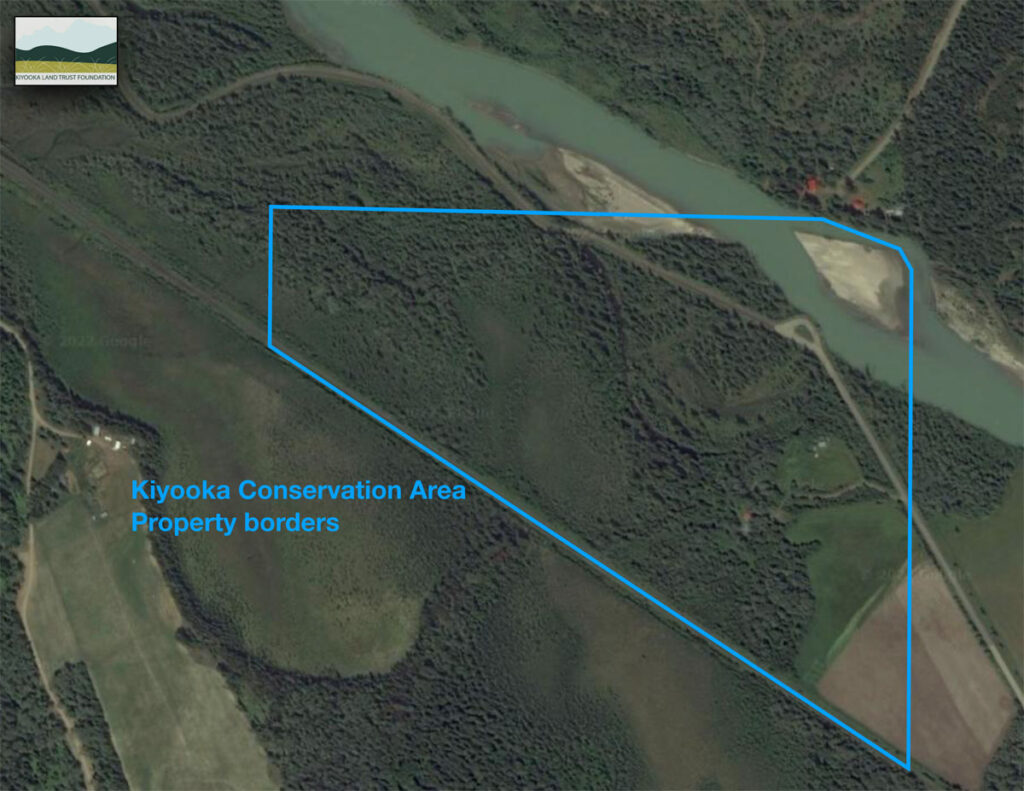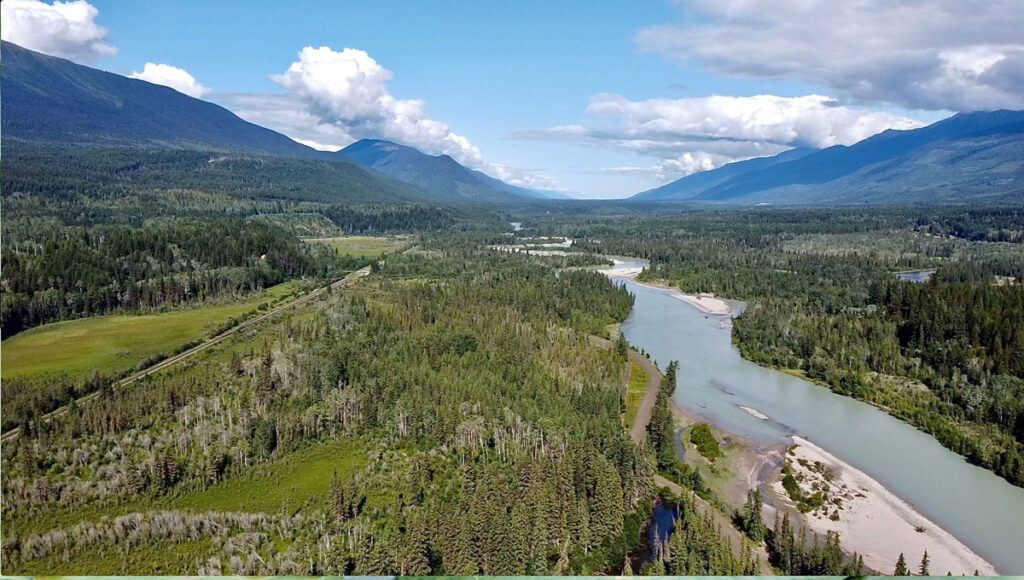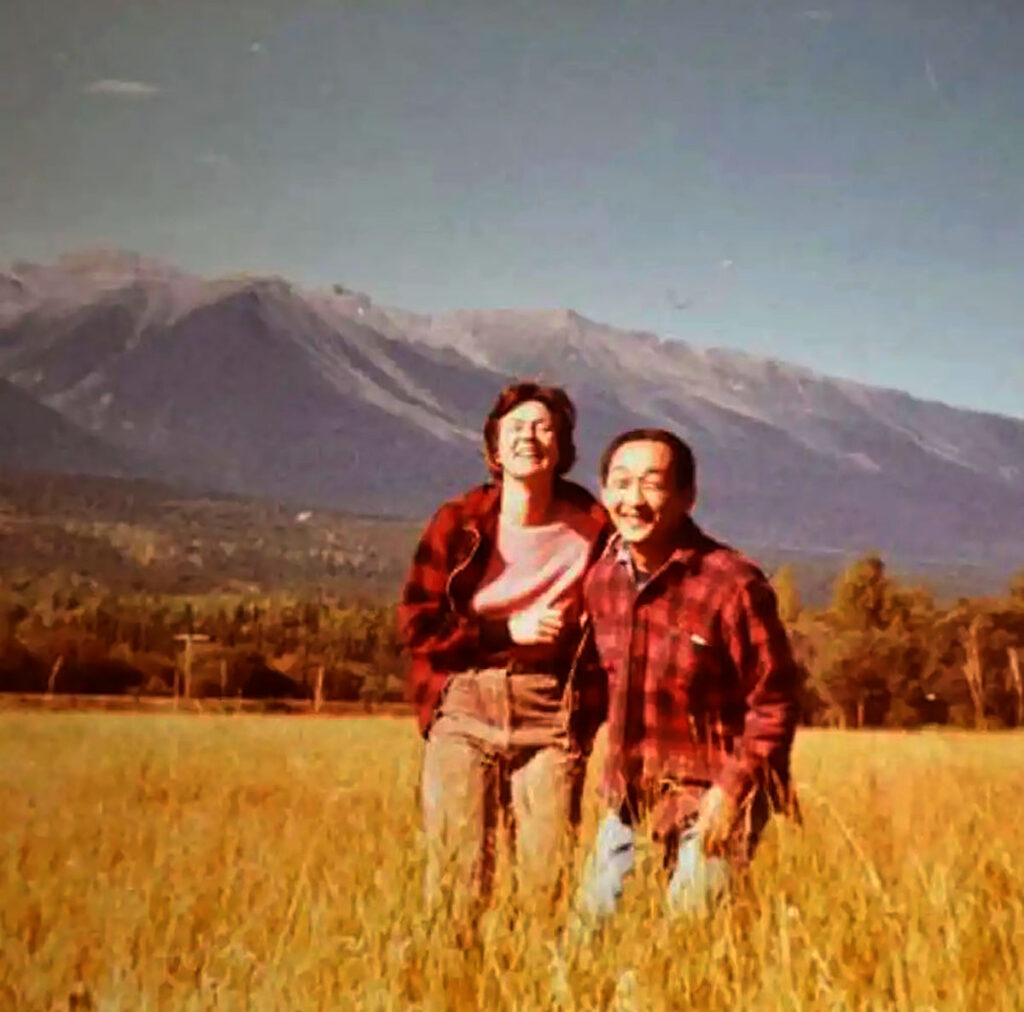By Laura Keil
A 72-acre property along the Fraser River will be preserved ecologically after being purchased by the newly-formed Kiyooka Land Trust Foundation.
Hanae Kiyooka was 12 years old when her parents moved their family from Hinton to Tete Jaune, to a rustic property along the Fraser River.
Some of the land had been cleared, and a photograph taken in the 1970s shows a joyful Frank and Ann Kiyooka in a field.
Today the property still bears a small field, but changes are apparent: many more trees, both ones they planted and ones they allowed to grow in. Older buildings have collapsed back into the earth. Still holding its ground is the Kiyooka family’s three-story house with a wall of east-facing windows, the house where Hanae and her siblings spent many formative years.
“My father and mother both, from the beginning, understood the value of land for its own sake, you know, that it didn’t need to be monetized or commercialized – that its value was in it, in and of itself. And I think, as I grew into my adult years, I have become more and more conscious of that, and appreciative of my parents’ understanding.”
It wasn’t the most exciting place for Hanae to live as a teenager – looking out the window you wouldn’t catch sight of another house. But the property adjoined the Fraser River.
“I learned to live in a very quiet environment, to just be comfortable in nature,” she said. “I got to see black bears coming up in front of the window and the birds and walking down to the river and seeing the salmon spawning, not knowing I was getting an education. I was immersed in it on a day-to-day basis, and that just can’t help but influence you.”
Hanae and her husband Jeff Gusdal recently purchased the property from her parents’ estate, with some help from Hanae’s siblings. Together with a grant from the federal government and private donations, it was possible to transfer the property to the Kiyooka Land Trust to be preserved as a natural area in perpetuity. It honours Hanae’s parents’ wish that the land remain a natural protected area, the natural and human history be recognized, and the property serve as a community resource.
“We hope, possibly, that it’ll be a catalyst for more conservation,” she said. “We could potentially have the capacity to help conserve other properties as well.”
The land is primarily a wetland riparian area, with a section bordering the Fraser River. It also has mature stands of white spruce, cottonwood, and aspen. Kiyooka says valley-bottom land is important for wildlife habitat and rarely conserved because it tends to be inhabited by people. But it’s is crucial to provide wildlife corridors and also for grazing areas and habitat for different species. She says this property has a lot of ungulate activity. Other wildlife – such as toads and salmon – have declined significantly in recent years.

She says mammals with large territorial needs like grizzly bears and lynx are reliant on the corridor and two species at risk, the western toad (special concern) and the great blue heron (special concern), have been observed on the land. Environment and Climate Change Canada also established wetlands as a high priority conservation habitat. Wetlands improve climate change resilience, acting as carbon sinks and providing services such as natural flood mitigation, preventing erosion, recharging ground water aquifers, and potential to slow wildfire progression.
Kiyooka says they chose to create a new land trust rather than donating the property to an existing one for several reasons – one is a locally-famous case of a land trust re-selling a local property that had been donated. And the second was that the property still had a mortgage, which made it difficult to donate outright. Local control was also important.
“Decision making that happens close in the community really appealed to us.”
Kiyooka hopes that this move will inspire others to look at how they can preserve their properties ecologically down the road, for instance, by registering covenants. She says land owners can hold conservation covenants jointly with a land trust.
“We’re in an age where, you know, we need to be mitigating the effects of the human impact, by balancing that with the wildlife and biodiversity, and recognizing we are in a biodiversity and climate crisis right now. How can we all encourage one another to work towards living more in harmony in nature?”
In her own life, it has often been a struggle to be positive.
“I can get kind of despairing about the state of the world. Kind of helpless. But working on something like this is so tangible, that is really uplifting and energizing.”
The Trust’s board is planning an event for the last weekend in May to celebrate the new Land Trust and opportunities it could bring. They are inviting locals to share their ideas on how the property might be used for conservation or research. They hope to partner with universities and Indigenous people and offer the house as a place to stay to visiting researchers, Indigenous partners and artists whose work aligns with the Trust’s mandate and vision. Previously the house on the land was rented out to artists and families as the Living Arts Retreat.
Kiyooka says they are looking for more local directors for the Trust’s board and invite people to get involved either at a board or volunteer level.
“We want to make this something that really benefits the local community,” she says.
For Kiyooka, the property transfer is a dream come true.
“I just see my parents smiling,” Kiyooka. “I know there’s a lot of people that knew who my mom and dad were, and I’m just so grateful that we were able to do this … They loved their community and they also loved the land.”
She says the land trust will benefit wildlife and improve the health of the planet. “And I include humans in that – we’re all interconnected.”
To learn more visit kiyookalandtrust.org





